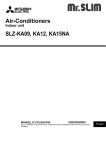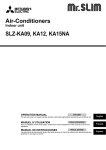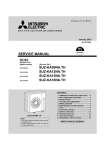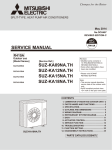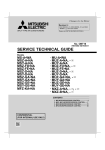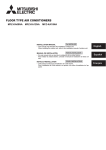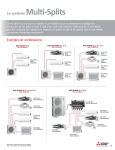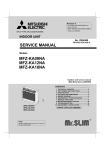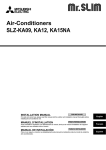Download Air-Conditioners SLZ-KA09, KA12, KA15NA
Transcript
Air-Conditioners Indoor unit SLZ-KA09, KA12, KA15NA OPERATION MANUAL FOR USER For safe and correct use, please read this operation manual thoroughly before operating the air-conditioner unit. English Français Contents 1. 2. 3. 4. Safety Precautions ..........................................................................................2 Parts Names....................................................................................................3 Operation.........................................................................................................4 Timer ...............................................................................................................4 5. 6. 7. 8. Care and Cleaning ..........................................................................................5 Trouble Shooting .............................................................................................5 Installation, relocation and inspection .............................................................7 Specifications ..................................................................................................8 1. Safety Precautions ► Before installing the unit, make sure you read all the “Safety Precautions”. ► The “Safety Precautions” provide very important points regarding safety. Make sure you follow them. ► Please report to or take consent by the supply authority before connection to the system. Symbols used in the text Warning: Describes precautions that should be observed to prevent danger of injury or death to the user. Caution: Describes precautions that should be observed to prevent damage to the unit. Symbols used in the illustrations : Warning: • The unit must not be installed by the user. Ask the dealer or an authorized company to install the unit. If the unit is installed improperly, water leakage, electric shock or fire may result. • Do not stand on, or place any items on the unit. • Do not splash water over the unit and do not touch the unit with wet hands. An electric shock may result. • Do not spray combustible gas close to the unit. Fire may result. • Do not place a gas heater or any other open-flame appliance where it will be exposed to the air discharged from the unit. Incomplete combustion may result. • Do not remove the front panel or the fan guard from the outdoor unit when it is running. Caution: • Do not use any sharp object to push the buttons, as this may damage the remote controller. • Never block or cover the indoor or outdoor unit’s intakes or outlets. 2 Indicates a part which must be grounded. • When you notice exceptionally abnormal noise or vibration, stop operation, turn off the power switch, and contact your dealer. • Never insert fingers, sticks etc. into the intakes or outlets. • If you detect odd smells, stop using the unit, turn off the power switch and consult your dealer. Otherwise, a breakdown, electric shock or fire may result. • This air conditioner is NOT intended for use by children or infirm persons without supervision. • Young children must be supervised to ensure that they do not play with the air conditioner. • If the refrigeration gas blows out or leaks, stop the operation of the air conditioner, thoroughly ventilate the room, and contact your dealer. Disposing of the unit When you need to dispose of the unit, consult your dealer. 2. Parts Names Indoor Unit Indoor unit 4-way Ceiling Cassette SLZ-KA·NA Fan steps Vane Louver Filter Filter cleaning indication Vane Filter 3 steps Auto with swing — Long-life 2,500 hr Air outlet Air intake ■ Outdoor unit Power Ref. Pipes Indoor-Outdoor Connection wire Earth ■ Remote controller (Optional parts) Wired remote controller TEMP. ON/OFF 3 3. Operation ■ About the operation method, please refer to the operation manual that comes with each remote controller. ■ Because the room temperature is automatically adjusted in order to maintain a fixed effective temperature, cooling operation is performed a few degrees warmer and heating operation is performed a few degrees cooler than the set room temperature once the temperature is reached (automatic energy-saving operation). 3.1. Turning ON/OFF Note: Even if you press the ON/OFF button immediately after shutting down the operation is progress, the air conditioner will not start for about 3 minutes. This is to prevent the internal components from being damaged. 3.3. Fan speed setting Cool/ Dry/ Fan/ Heat/ Automatic (cool/ heat)/ ventilation mode are available. Note: ● Heat and Automatic modes can not be available for cooling only units. ● Ventilation mode: only indicated on the following condition. Wired remote controller is used and LOSSNAY is connected. Note: ● The number of available fan speeds depends on the type of unit connected. ● In the following cases, the actual fan speed generated by the unit will differ from the speed shown the remote controller display. 1. When the unit is in “STAND BY” or “DEFROST” states. 2. When the temperature of the heat exchanger is low in the heating mode. (e.g. immediately after heating operation starts) 3. In HEAT mode, when room temperature is higher than the temperature setting. 4. When the unit is in DRY mode. Information for multi system air conditioner (Outdoor unit: MXZ series) 3.4. Airflow direction setting 3.2. Operation mode select ► Multi system air conditioner (Outdoor unit: MXZ series) can connect two or more indoor units with one outdoor unit. According to the capacity, two or more units can operate simultaneously. • When you try to operate two or more indoor units with one outdoor unit simultaneously, one for the cooling and the other for heating, the operation mode of the indoor unit that operates earlier is selected. The other indoor units that will start the operation later cannot operate, indicating an operation state in flashing. In this case, please set all the indoor units to the same operation mode. (AUTO) • There might be a case that the indoor unit, which is operating in mode. Cannot change over to the operating mode (COOL ↔ HEAT) and becomes a state of standby. • When indoor unit starts the operation while the defrosting of outdoor unit is being done, it takes a few minutes (max. about 15 minutes) to blow out the warm air. • In the heating operation, though indoor unit that does not operate may get warm or the sound of refrigerant flowing may be heard, they are not malfunction. The reason is that the refrigerant continuously flows into it. ■ According to a set temperature, cooling operation starts if the room temperature is too hot and heating operation starts if the room temperature is too cold. During automatic operation, if the room temperature changes and remains 2 °C, 4 °F or more above the set temperature for 15 minutes, the air conditioner switches to cooling mode. In the same way, if the room temperature remains 2 °C, 4 °F or more below the set temperature for 15 minutes, the air conditioner switches to heating mode. Cooling mode 15 minutes (switches from heating to cooling) Set temperature +2°C, +4°F Set temperature Set temperature -2°C, -4°F 15 minutes (switches from cooling to heating ) 4. Timer ■ Timer functions are different by each remote controller. ■ For details on how to operate the remote controller, refer to the appropriate operation manual included with each remote controller. 4 3.5. Ventilation For LOSSNAY combination ● The following 2 patterns of operation is available. Automatic operation ■ Note: ● During swing operation, the directional indication on the screen does not change in sync with the directional vanes on the unit. ● Available directions depend on the type of unit connected. ● In the following cases, the actual air direction will differ from the direction indicated on the remote controller display. 1. When the unit is in “STAND BY” or “DEFROST” states. 2. Immediately after starting heater mode (while the system is waiting for the mode change to take effect). 3. In heat mode, when room temperature is higher than the temperature setting. • Run the ventilator together with the indoor unit. • Run the ventilator independently. ● ● 5. Care and Cleaning ► Filter removal ■ Following indication shows that the filter needs cleaning. • Wired remote controller: “FILTER” Ask authorized people to clean the filter. Caution: • In removing the filter, precautions must be taken to protect your eyes from dust. Also, if you have to climb up on a stool to do the job, be careful not to fall. • When the filter is removed, do not touch the metallic parts inside the indoor unit, otherwise injury may result. ■ When resetting “FILTER” or “Clean Filter” display. Resetting the indication, refer to the operation manual of each remote controller. Note: ● When 2 or more different types of indoor unit are controlled, the cleaning ● ● ■ SLZ-KA·NA period differs with the type of filter. When the master unit cleaning period arrives, “FILTER” is displayed. When the filter display goes off, the cumulative time is reset. (Only for wired remote controller.) “FILTER” or “Clean Filter” indicates the cleaning period when the air conditioner was used under general indoor air conditions by criteria time. Since the degree of dirtiness depends on the environmental conditions, clean the filter accordingly. The filter cleaning period cumulative time differs with the model. ► Cleaning the filters • Clean the filters using a vacuum cleaner. If you do not have a vacuum cleaner, tap the filters against a solid object to knock off dirt and dust. • If the filters are especially dirty, wash them in lukewarm water. Take care to rinse off any detergent thoroughly and allow the filters to dry completely before putting them back into the unit. • • • • • Caution: Do not dry the filters in direct sunlight or by using a heat source, such as an electric heater: this may warp them. Do not wash the filters in hot water (above 122°F), as this may warp them. Make sure that the air filters are always installed. Operating the unit without air filters can cause malfunction. Before you start cleaning, stop operation and turn OFF the power supply. Indoor units are equipped with filters to remove the dust of sucked-in air. Clean the filters using the methods shown in the following sketches. Pull the knob on the intake grille in the direction indicated by the arrow and it should open. Open the intake grille. Release the knob on the center edge of the intake grille and pull the filter forward to remove the filter. Knob Grille Intake grille Filter 6. Trouble Shooting Having trouble? Air conditioner does not heat or cool well. Here is the solution. (Unit is operating normally.) ■ Clean the filter. (Airflow is reduced when the filter is dirty or clogged.) ■ Check the temperature adjustment and adjust the set temperature. ■ Make sure that there is plenty of space around the outdoor unit. Is the indoor unit air intake or outlet blocked? When heating operation starts, warm air does not blow from the indoor unit soon. During heating mode, the air conditioner stops before the set room temperature is reached. When dry mode starts, the set temperature changes. ■ Has a door or window been left open? ■ Warm air does not blow until the indoor unit has sufficiently warmed up. ■ When the outdoor temperature is low and the humidity is high, frost ■ may form on the outdoor unit. If this occurs, the outdoor unit performs a defrosting operation. Normal operation should begin after approximately 10 minutes. When dry mode starts, the set temperature automatically changes to the optimum initial set temperature. 5 6. Trouble Shooting Having trouble? Airflow direction changes during operation or airflow direction cannot be set. Here is the solution. (Unit is operating normally.) ■ During cooling mode, the vanes automatically move to the horizontal ■ When the airflow direction is changed, the vanes always move up and down past the set position before finally stopping at the position. A flowing water sound or occasional hissing sound is heard. ■ A cracking or creaking sound is heard. ■ The room has an unpleasant odor. ■ A white mist or vapor is emitted from the indoor unit. ■ ■ ■ Water or vapor is emitted from the outdoor unit. ■ ■ ■ The operation indicator does not appear in the wired remote controller display. (*1) “ ” appears in the wired remote controller display. (*1) ■ When restarting the air conditioner soon after stopping it, it does not operate even though the ON/OFF button is pressed. Air conditioner operates without the ON/OFF button being pressed. (*1) ■ ■ ■ ■ ■ ■ Air conditioner stops without the ON/OFF button being pressed. (*1) ■ ■ ■ Wired remote controller timer operation cannot be set. (*1) ■ “PLEASE WAIT” appears in the wired remote controller display. (*1) ■ An error code appears in the remote controller display. ■ ■ Draining water or motor rotation sound is heard. ■ Noise is louder than specifications. ■ (down) position after 1 hour when the down (horizontal) airflow direction is selected. This is to prevent water from forming and dripping from the vanes. During heating mode, the vanes automatically move to the horizontal airflow direction when the airflow temperature is low or during defrosting mode. When the airflow direction is changed, the vanes move to the set position after detecting the base position. These sounds can be heard when refrigerant is flowing in the air conditioner or when the refrigerant flow is changing. These sounds can be heard when parts rub against each due to expansion and contraction from temperature changes. The indoor unit draws in air that contains gases produced from the walls, carpeting, and furniture as well as odors trapped in clothing, and then blows this air back into the room. If the indoor temperature and the humidity are high, this condition may occur when operation starts. During defrosting mode, cool airflow may blow down and appear like a mist. During cooling mode, water may form and drip from the cool pipes and joints. During heating mode, water may form and drip from the heat exchanger. During defrosting mode, water on the heat exchanger evaporates and water vapor may be emitted. Turn on the power switch. “ ” will appear in the wired remote controller display. During central control, “ ” appears in the wired remote controller display and air conditioner operation cannot be started or stopped using the wired remote controller. Wait approximately three minutes. (Operation has stopped to protect the air conditioner.) Is the on timer set? Press the ON/OFF button to stop operation. Is the air conditioner connected to a central wired remote controller? Consult the concerned people who control the air conditioner. Does “ ” appear in the wired remote controller display? Consult the concerned people who control the air conditioner. Has the auto recovery feature from power failures been set? Press the ON/OFF button to stop operation. Is the off timer set? Press the ON/OFF button to restart operation. Is the air conditioner connected to a central wired remote controller? Consult the concerned people who control the air conditioner. Does “ ” appear in the wired remote controller display? Consult the concerned people who control the air conditioner. Are timer settings invalid? If the timer can be set, , , or appears in the wired remote controller display. The initial settings are being performed. Wait approximately 3 minutes. The protection devices have operated to protect the air conditioner. Do not attempt to repair this equipment by yourself. Turn off the power switch immediately and consult your dealer. Be sure to provide the dealer with the model name and information that appeared in the remote controller display. When cooling operation stops, the drain pump operates and then stops. Wait approximately 3 minutes. The indoor operation sound level is affected by the acoustics of the particular room as shown in the following table and will be higher than the noise specification, which was measured in an echo-free room. Location examples Noise levels *1: Only for wired remote controller. 6 High soundabsorbing rooms Broadcasting studio, music room, etc. 3 to 7 dB Normal rooms Reception room, hotel lobby, etc. 6 to 10 dB Low sound-absorbing rooms Office, hotel room 9 to 13 dB 7. Installation, relocation and inspection Installation place Avoid installing the air conditioner in the following places. • Where flammable gas could leak. Caution: Do not install the unit where flammable gas could leak. If gas leaks and collects around the unit, it may cause an explosion. Inverter type fluorescent lamp Wall, etc. • • • • Where there is much machine oil. Salty place such as the seaside. Where sulfide gas is generated such as a hot spring. Where there is oil splashing or much oily smoke. To prevent the effect of a fluorescent lamp, keep it away as far apart as possible. Warning: If the air conditioner operates but does not cool or heat (depending on model) the room, consult your dealer since there may be a refrigerant leak. Be sure to ask the service representative whether there is refrigerant leakage or not when repairs are carried out. The refrigerant charged in the air conditioner is safe. Refrigerant normally does not leak, however, if refrigerant gas leaks indoors, and comes into contact with the fire of a fan heater, space heater, stove, etc., harmful substances will be generated. Well-ventilated dry place To prevent picture distortion or noise, keep 3 ft (1 m) or more apart. 4 inch (100 mm) or more TV 8 inch (200 mm) or more Radio Electrical work • Provide an exclusive circuit for power supply of the air conditioner. • Be sure to observe the breaker capacity. Warning: • The customer should not install this unit. If the unit is installed incorrectly, fire, electric shock, injury due to a falling unit, water leakage, etc. may result. • Do not connect using branched outlet or an extension cord, and do not attach many loads to one electric outlet. A fire or electric shock may result from poor contact, poor insulation, exceeding the permissible current, etc. Consult your dealer. Caution: • Apply grounding Do not connect a grounding wire to a gas pipe, water pipe, lightning rod or ground wire of a telephone. If a grounding is incorrect, it may cause an electric shock. • Install an earth leakage breaker depending on the place where the air conditioner is to be installed (humid place, etc.). If the earth leakage breaker is not installed, it may cause an electric shock. Inspection and maintenance • When the air conditioner is used for several seasons, the capacity may be lowered due to dirt inside the unit. • Depending upon the conditions of use, an odor may be generated or dirt, dust, etc. may prevent proper drainage. • It is recommended to apply inspection and maintenance (charged) by a specialist in addition to normal maintenance. Consult your dealer. Also consider operation sound • Do not put an object around the air outlet of the outdoor unit. It may cause lowering of capacity or increase operating sound. • If abnormal sound is heard during operation, consult your dealer. Relocation • When the air conditioner is to be removed or reinstalled because of rebuilding, moving, etc., special techniques and work are required. Warning: Repair or relocation should not be done by the customer. If this is done incorrectly, it may cause a fire, electric shock, injury by dropping of the unit, water leakage, etc. Consult your dealer. Disposal • To dispose of this product, consult your dealer. If you have any question, consult your dealer. 7 8. Specifications Model Power source Fan motor MCA MOCP Dimension Airflow (Low-Middle-High) Noise level (Low-Middle-High) Net weight SLZ-KA09NA <FLA> <A> <A> (Height) <inch> (Width) <inch> (Depth) <inch> DRY <CFM> WET <CFM> <dB> <lbs> *1 The figure in ( ) indicates GRILL'S. 8 0.23 280-320-350 250-290-320 29-32-38 SLZ-KA12NA Single 208/230V, 60Hz 0.28 1 15 8-3/16 (25/32) 22-7/16 (25-19/32) 22-7/16 (25-19/32) 280-320-390 250-290-350 30-34-39 36 (7) SLZ-KA15NA 0.28 280-320-390 250-290-350 31-35-40 This product is designed and intended for use in the residential, commercial and light-industrial environment. Please be sure to put the contact address/telephone number on this manual before handing it to the customer. HEAD OFFICE: TOKYO BLDG., 2-7-3, MARUNOUCHI, CHIYODA-KU, TOKYO 100-8310, JAPAN RG79D588H01 Printed in Thailand









